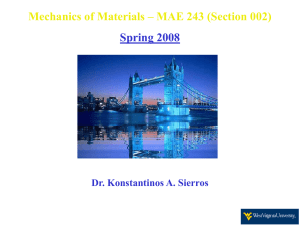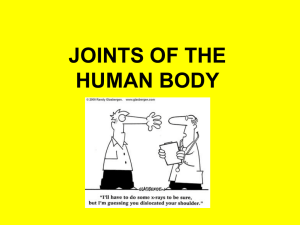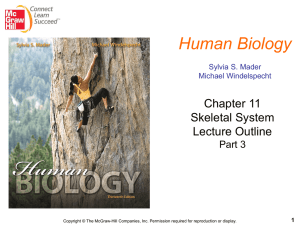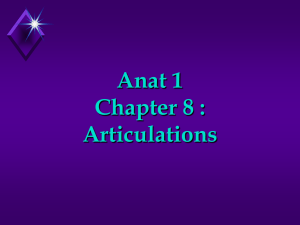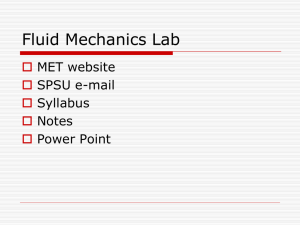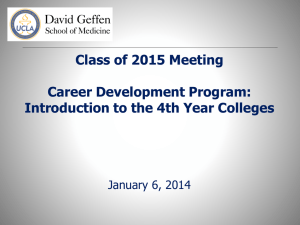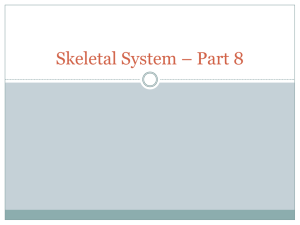PowerPoint
advertisement
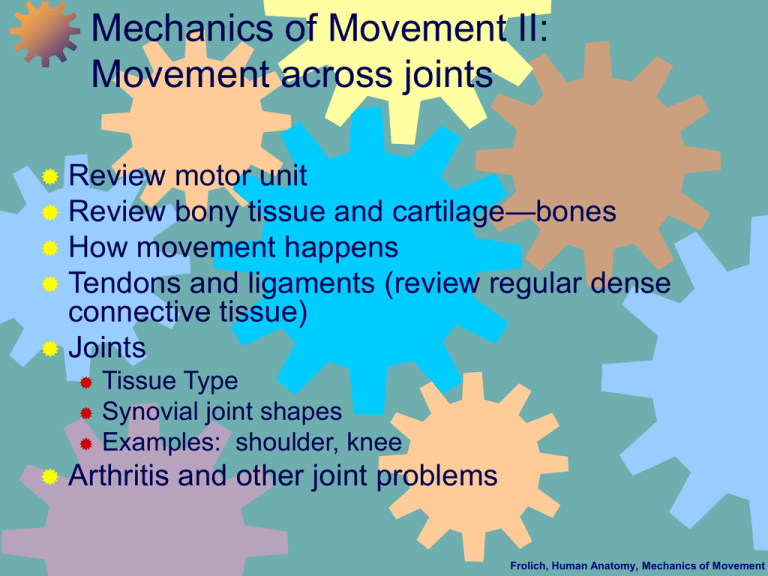
Mechanics of Movement II: Movement across joints Review motor unit Review bony tissue and cartilage—bones How movement happens Tendons and ligaments (review regular dense connective tissue) Joints Tissue Type Synovial joint shapes Examples: shoulder, knee Arthritis and other joint problems Frolich, Human Anatomy, Mechanics of Movement Nerve and Muscle--the Motor Unit Motor neurons review Ventral horn spinal cord Travels through spinal nerve and branches to skeletal muscle One motor neuron synapses with several muscle cells Motor Unit is one motor neuron plus the muscle cells it synapses with and stimulates Frolich, Human Anatomy, Mechanics of Movement Bone and Cartilage Bone as tissue Bones as structures formed from bone, cartilage and other tissues Location of cartilage in skeleton and relation to joints Frolich, Human Anatomy, Mechanics of Movement HOW MOVEMENT HAPPENS: Muscles Pull on Tendons to Move Bones at Connections called Joints or Articulations Frolich, Human Anatomy, Mechanics of Movement Regular dense connective tissue Musculo-skeletal connections— tendons and ligaments Muscle to bone Muscle to muscle Bone to bone Frolich, Human Anatomy, Mechanics of Movement Tendons Tendons are structures that connect bone to muscle and Can have various shapes Typical is cord-like tendon of biceps Sheeths are common--”aponeuroses” e.g. acromiotrapezius origin from thoracic vertebral spines Frolich, Human Anatomy, Mechanics of Movement Ligaments Ligaments connect boneto-bone or reinforce joints E.g. knee ligaments Frolich, Human Anatomy, Mechanics of Movement Joints or Articulations Connections between bones Usually, but not always allow for movement Formed from various connective tissues Fibrous Cartilaginous Synovial (most complex--typical limb joints) Frolich, Human Anatomy, Mechanics of Movement Fibrous joints Suture Bones tightly bound by minimal fiber Only found in skull Syndemoses Bones connected by ligaments E.g. tibiofibular ligament, interosseous membrane of radius/ulna Gomphoses Peg in socket joint Only found in teeth/alveoli Fig. 9.1 a, M&M Frolich, Human Anatomy, Mechanics of Movement Fibrous joints Suture Bones tightly bound by minimal fiber Only found in skull Syndemoses Bones connected by ligaments E.g. tibiofibular ligament, interosseous membrane of radius/ulna Gomphoses Peg in socket joint Only found in teeth/alveoli Fig. 9.1 b, M&M Fig. 8.4, M&M Frolich, Human Anatomy, Mechanics of Movement Fibrous joints Suture Syndemoses Bones tightly bound by minimal fiber Only found in skull Bones connected by ligaments E.g. tibiofibular ligament, interosseous membrane of radius/ulna Gomphoses Peg in socket joint Only found in teeth/alveoli Fig. 9.1 c, M&M Frolich, Human Anatomy, Mechanics of Movement Cartilaginous Joints Synchondrosis Hyaline cartilage unites bones Epiphyseal growth plates Costal cartilage-sternum Symphyses Fibrocartilage unites bones Pubic symphysis Intervertebral disc Frolich, Human Anatomy, Mechanics of Movement Synovial Joints Most common joints in body Most mobile joints Have Articular surfaces on bone with hyaline cartilage Completely enclosed joint capsule formed from ligamentous connective tissue Synovial fluid within capsule lubricates joint Some have meniscus or articular disc(e.g. knee, jaw joint) Frolich, Human Anatomy, Mechanics of Movement Also see Fig. 9.3, M&M Frolich, Human Anatomy, Mechanics of Movement Frolich, Human Anatomy, Mechanics of Movement Synovial Joint Shape Types Plane joints--intercarpal joints Hinge joints--elbow,ankle, interj-phalangeal Pivot joints--radio-ulnar joint Condyloid joints (egg into oval)--metacarpophalangeal Saddle joints--carpo-metacarpal joint of thumb Ball-and-socket--hip, shoulder The type of joint, in part, determines the range and direction of movement Frolich, Human Anatomy, Mechanics of Movement Fig. 9.9, M&M Frolich, Human Anatomy, Mechanics of Movement Frolich, Human Anatomy, Mechanics of Movement Frolich, Human Anatomy, Mechanics of Movement Frolich, Human Anatomy, Mechanics of Movement Frolich, Human Anatomy, Mechanics of Movement Frolich, Human Anatomy, Mechanics of Movement X-ray of hand affected by arthritis Frolich, Human Anatomy, Mechanics of Movement Artificial Hip Joint Frolich, Human Anatomy, Mechanics of Movement Arthritis Information From American Physical Therapists Association (good preventative info) Arthritis stats from CDC (leading cause of disability) Health Info from NIAMS (National Institute of Arthritis, Musculoskeletal and Skin Diseases) Frolich, Human Anatomy, Mechanics of Movement

